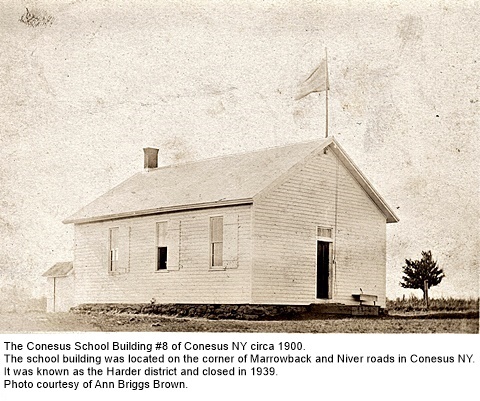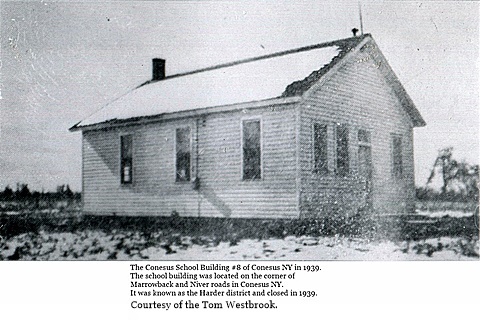
Welcome to Hemlock and Canadice Lakes!
Barns Businesses Cemeteries Churches Clinton & Sullivan Columns Communities Documents Events Time Line Fairs & Festivals Farm & Garden Hiking Homesteads Lake Cottages Lake Scenes Landscapes Library News Articles Old Maps Old Roads & Bridges Organizations People Photo Gallery Podcasts Railroad Reservoir Schools State Forest Veterans Videos
|
School House #8 in Conesus NY |
|
|
Click an image to enlarge. |
|
|
1 |
School #8 in Conesus NY circa 1900. Located on Marrowback road at Niver road. The school building was located on the corner of Marrowback and Niver roads in Conesus NY. It was known as the Harder district and closed in 1939. Photo courtesy of Ann Briggs Brown.
|
|
2 |
School #8 in Conesus NY circa 1939 Located on Marrowback road at Niver road. The school building was located on the corner of Marrowback and Niver roads in Conesus NY. It was known as the Harder district and closed in 1939. Photo courtesy of Tom Westbrook.
|
|
School #8 in Conesus NY circa 1900 Located on Marrowback road at Niver road. Livonia Gazette 4 July 1940 By W. Scott Marsh Agreeable to the request of the editor of the Livonia Gazette, our always welcome paper, I am attempting to compile a record of the district now known at No. 8, of Conesus and Livonia, a member of the Livonia Central district and commonly known as the Harder district. Most of the credit for this narration goes to Mrs. Lulu Briggs, a classmate of the writer, who not only loaned the book of the old record, but very courteously helped in establishing some of the facts and dates, hereinafter mentioned. It may be known that Mrs. Briggs is the daughter of the late George Harder, who holds the distinction of being the longest holder of office in the district, with terms extending over a period from 1883 to 1918. Among other long-term office-holders were Lyman Sharpe, who held the office of chaplain and collector for some twenty-eight years; and Gilbert N. Marsh, who held the office of moderator from 1846 to 1855. Other notables are William Coe, Henry Spencer, Ephraim Wright, Hector Hithcock, Close Palmer and perhaps many others whose names did not appear on the old records. At this point it might be of interest to note that officers of the district scheduled included chaplain, moderator, district clerk, trustee, collector and librarian. In addition to this complete set of officers, a committee of five members was appointed to see that the officers carried out the duties of their offices. Even at this early date efficiency reigned supreme. The old record of the district starts April 11, 1825, with Timothy Bailey, moderator; Close N. Palmer, district clerk; Elisha H. Luther, chaplain; and John Jackson, trustee. The district was then known as district No. 15 of Conesus and Livonia. It extended north in Livonia as far as the Wilbur S. Jerome farm, south in Conesus as far as the N. C. Marsh farm, east along the shores of Hemlock lake, and on the west in Livonia and Conesus, one farm deep along the Conesus-Livonia Center state highway from the Jerome farm north to the Franklin Foote farm on the south. It embraced approximately twenty-nine parcels of property. One noteworthy school meeting on record, dated April 6, 1841, had as officers: A. L. Chapin, moderator; Benjamin J. Hillman, trustee; Almond N. Shephard, chaplain, and Almond Welch, collector. The resolution was as follows: “That we raise $35.24 for teachers’ wages, $3.31 for repairs, and $5.60 for contingent fund, with $17.05 of public money.” The resolution was further extended that each pupil bring one-third of cord of wood for heating purposes, and upon their failure to do so a fine of $1.25 is to be imposed against such pupils, to be collected by the trustee from the parents of the delinquent pupils. As a matter of economy it is a noteworthy fact that the school was in session from 1825 to 1896 before the taxes reached the $100 mark. At this time the registered enrollment was thirty-one pupils. Here it might be well to mention that a term of school comprised sixteen weeks, with two school meetings, held generally in April and October, and on some occasions a full set of officers was elected at each meeting. Another fact from the records shows that in 1855 a collector was presented with a warrant to collect $61, and upon his failure to resent sufficient bonds a special school meeting was called. Benjamin Warrington was choosen collector in his place. Even in those days it is plain to see that the old boys didn’t intend to let anything slip away. On August 17, 1844, a special school meeting was called to consider building a new school house. The officers were: B. L. Hillman, moderator; Gilbert N. Marsh, clerk; Benjamin Warrington, trustee; Lyman Sharpe, collector. Each voter’s name is recorded in the book of the old records, and shows that they voted by “aye” and “nay.” The proposition was carried by eleven majority, but not further action was ever taken on this proposition. Some of the teachers who held forth in district No. 15, dating way back to the days of Andrew Jackson, were: Ann Harder, Ed. Woodruff, Orlando Morris, Mary Anne Marsh Payne in 1856; Mary Harder and Susan Webster, of whom was told the following story: Upon spying a young man of 19 stuff a paper wad down the back of another pupil, she requested him to come up in front. When he refused to do so she seized him, cracked his heels against the stove, boxed him until his hair stood up straight, and as she turned him face to the wall she advised him that God made little boys to come to school, attend to their own business, and mind. Upon second consideration this advice was adhered to strictly. Of course there were many other teachers during this era, but the writer would have no knowledge of them. And so the district went on, much as in the manner mentioned, until a school meeting of October 11, 1864. The officers were: W. C. Turner, clerk; Ansol Converse, trustee; Lyman Sharpe, librarian; and Lyman Sharpe, collector. During this meeting the district was changed from No. 15 to No. 8 without adequate explanation of record as to why. This, therefore, concludes the records of the older days in district No. 15. On August 31, 1886, a meeting was called for the purpose of discussion of a new school building. The officers were: George Harder, clerk; Mrs. Ann Harder, trustee; Cary Johnson, collector; Lyman Sharpe, librarian. The motion proposing a new school building was carried. George Harder, Wm. Smith and Oliver Hills were appointed a committee to see that the work was carried out under the contract, as follows: Harvey Ripley was to build the school house from the “ground to the top” for a sum of $520. The building specifications were that the building was to be 24x35 feet, with 12-foot posts and a wall 2 feet high and 8 inches thick. The building was to be sheeted on the outside with novelty siding, and the roof was to be shingled. The interior was to be scaled, equipped with desks, and a Norway pine flooring. The building was to be painted and ready for school purposes thirty days after the date of the contract. Mrs. Alta Skinner Cole taught the first term of school in the new building in 1887. The term now extended through the fall and winter. This school continued until it was closed and included in the Livonia Central district in 1939. It closed with Mrs. Mae Lake, trustee; Charles Briggs, clerk, succeeding George Harder, deceased; and Hugh Pickering, collector. Mrs. Leonard Briggs was the last teacher. Through this later period the writer has a better conception of the teachers who taught, as he was a scholar himself, starting in the early 90’s with Hattie Meyers as his first teacher; continuing with John Bearss, Florence McDonald, Lora Bishop, Arthur P. Reed (now Dr. Reed of Rochester), and finally graduating under Frank L. Partridge. Since the time of his school days the writer has held all of the offices in the district, with the exception of district clerk. During the writer’s school days there are many fond memories of games and sports. Especially clear is the fad for baseball that lingers until the present. The writer quite well remembers a critical point in an eventful ball game occurred when a lady now living in Hemlock, just rounding third base, lost her petticoat and still made the plate in time for full credit for a home run. A few teachers previous to the ones already mentioned were: Wilbur Jerome, Susie Jerome, Frederick L. Ducher (now Judge Dutcher of Rochester), Clara Simpson Coykendall, Mrs. H. H. Jerome, and many others whom limitations will not allow. The inclusion of this small district into a large central unit, the writer agrees is a step forward. Nevertheless, with the dissolution and removal of the old school house and district lines, many fond memories of old schoolmates and school days still linger. The writer watches his old Alma Mater vanish with keen regret.
|

